![]()
![]()
![]()
Use LEFT and RIGHT arrow keys to navigate between flashcards;
Use UP and DOWN arrow keys to flip the card;
H to show hint;
A reads text to speech;
35 Cards in this Set
- Front
- Back
|
Excretion |
Removal of waste products of metabolism from the body |
|
|
Excretion in Plants |
- Oxygen (from photosynthesis) by diffusion through stomata (+ lenticels) - Carbon Dioxide (from respiration) by diffusion through stomata + lenticels - Water (from respiration) by transpiration through stomata |
|
|
Excretion in Animals |
- Lungs: carbon dioxide + water vapour - Skin: water + salts (sweat) - Kidneys: water, salts + urea (excess protein) [urine] |
|
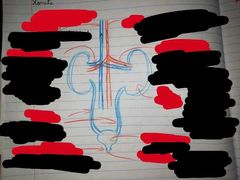
|
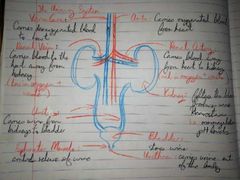
|
|
|
Structure of a Kidney |
Bean shaped organs located at back abdominal cavity |
|
|
Function of Vena Cava in Urinary System |
Carries deoxygenated blood to heart |
|
|
Function of Aorta in Urinary System |
Carries oxygenated blood from heary |
|
|
Function of Renal Vein in Urinary System |
Carries blood to the heart away from kidney (low in oxygen + waste) |
|
|
Function of Ureters in Urinary System |
Carries urine from kidneys to bladder |
|
|
Function of Sphincter Muscle in Urinary System |
Controls release of urine |
|
|
Function of Renal Artery in Urinary System |
Carries blood away from heart to kidney (rich in oxygen + waste) |
|
|
Function of Kidney in Urinary System |
Filters the blood. Produces urine. Homeostasis. i.e. Osmoregulation, pH levels |
|
|
Function of Bladder in Urinary System |
Stores urine |
|
|
Function of Urethra in Urinary System |
Carries urine out of the body |
|
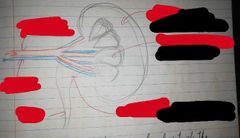
|
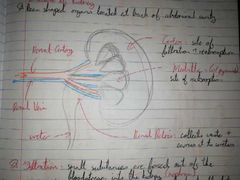
|
|
|
Function of Cortex in Kidney |
Site of filtration + reabsorption |
|
|
Function of Medulla in Kidney |
Site of Reabsorption |
|
|
Function of Renal Pelvis in Kidney |
Collects waste + carries it to ureters |
|
|
Filtration in Kidney |
Small substances are forced out of bloodstream into kidney (bowman's capsule of nephron). Occurs at glomerulus in Cortex. Forms glomerular filtrate. |
|
|
Reabsorption in Kidneys |
Useful substances are taken back into bloodstream from kidney (nephron) |
|
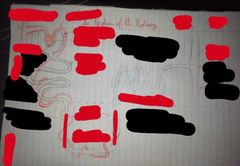
|
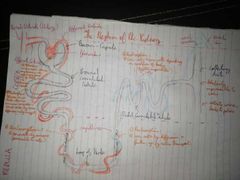
|
|
|
How glomerulus is adapted for filtration |
- Blood under high pressure (efferent arteriole narrower than afferent arteriole) - Large surface area - Walls of glomerulus capillaries are more porous - Walls of Bowman's Capsule very thin (1 cell thick) |
|
|
Filtration at Glomerulus |
Amino acids, vitamins, some hormones, water, salt + urea forced out of blood into Bowman's Capsule |
|
|
Reabsorption at Proximal Convulated Tubule |
Glucose, amino acids, vitamins, hormones, some water + some salts by osmosis, diffusion + active transport |
|
|
Reabsorption at Descending Loop of Henle |
Some water by osmosis (permeable to water) |
|
|
Reabsorption at Ascending Loop of Henle |
Some salts by diffusion + further up by active transport |
|
|
Reabsorption at Distal Convulated Tubule |
Some water + some salts depending on condition of body (slightly impermeable to water) |
|
|
Function of Collecting Duct in Nephron |
Relatively impermeable to water. Collects urine leads to Pelvis. |
|
|
Glomerular Filtrate vs. Blood |
- Has blood cells (red, white + platelets) - Has proteins - Has antibodies |
|
|
Glomerular Filtrate vs. Urine |
- Does not contain glucose, amino acids, vitamins - Has less water (more concentrated) |
|
|
Why are blood cells, proteins, antibodies + some hormones not present in glomerular filtrate? |
Too big to pass into glomerular filtrate |
|
|
Urine Production (Osmoregulation) |
1. Low water intake/ high salt intake 2. Salt concentration of plasma (blood) increases 3. Detected by brain 4. Triggers pituitary to release ADH (anti-diuretic hormone) 5. ADH travels in blood to kidneys 6. Makes walls of distal convulated tubule + collecting duct more permeable to water 7. More water is reabsorbed back into blood 8. Small volume of concentrated urine produced 9. Salt concentration of plasma (blood) decreases 10. Detected by brain 11. Pituitary gland inhibited i.e. No more ADH released 12. Walls of distal convulated tubule + collecting duct return to normal i.e. Slightly impermeable |
|
|
When is the only time pituitary gland is triggered + ADH released? |
Blood too concentrated (high salt/ low water) |
|
|
High protein diet |
No ADH produced, high volume of urea in urine |
|
|
High glucose in urine |
Diabetes |

